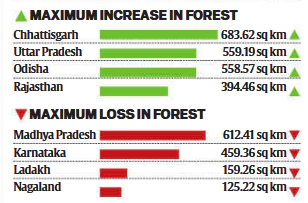Every year, March 21 is observed as the International Day of Forest (IDF) by the United Nations to commemorate the green cover around the world and reiterate its importance. The theme of the 2025 IDF is “Forests and Food“, celebrating the crucial role played by forests in food security, nutrition, and livelihoods.
Key Takeaways:
1. According to the UN website, the IDF celebrates and raises awareness of the importance of all types of forests. On this day, countries are encouraged to undertake local, national, and international efforts to organize activities involving forests and trees, such as tree-planting campaigns.
2. The Day is celebrated by the United Nations Forum on Forests and the Food and Agriculture Organization of the United Nations (FAO), in collaboration with governments, the Collaborative Partnership on Forests, and other relevant organisations in the field. It was first observed in 2012.
Importance of Forest
1. Forests are important to recharge drinking water and act as natural filters. Their root systems absorb excess nutrients and pollutants from rainfall-runoff before it enters aquifers, keeping water safe to consume.
2. Those same roots protect landslides by holding the soil together, combat flooding after heavy rainfall by aiding water absorption, and in the case of mangrove forests, act as a coastal bulwark during storms by buffering surges.
Story continues below this ad
3. The most important role of the forests is to ensure that we have enough food to eat, either through directly harboring fruit and wild animals that people eat, or by supporting agriculture through sheltering pollinators and supplying water.
4. They directly sustain the livelihoods of 1.6 billion people, providing timber, fuel, food, jobs, and shelter. About 300 million people live in forests. In India, to protect the livelihood of people dependent on forest has enacted the Scheduled Tribes and Other Traditional Forest Dwellers (Recognition of Forest Rights) Act, 2006 (FRA).
5. Forests support more than 80% of biodiversity on land, including 80% of amphibians, and 75% of birds. Tropical rainforests are especially heavy lifters, holding more than half the world’s vertebrate species.
6. Forests are the largest carbon sinks on the planet alongside oceans and soil. They hold vast quantities of climate-warming gases which are largely released by burning fossil fuels.
The world loses 10 million hectares annually due to deforestation, and approximately 70 million hectares are affected by fires. Protecting and restoring the forests is urgent and necessary: the well-being of the planet and future generations depends on them.
– United Nations
Story continues below this ad
7. Forest also helps to create clouds, which reflect sunlight back into space. They act as a natural air conditioner too when they release moisture into the air through evaporation.
BEYOND THE NUGGET: India State of Forest Report 2023
1. In December 2024, the Environment Ministry released the 18th biennial State of Forest Report (ISFR-2023). The ISFR is released biennially and involves forest cover mapping of the country using satellite data.
2. The net forest cover has increased by 156.41 sq km between 2021 and 2023 taking the geographical area under forest cover to 21.76 per cent, a paltry rise of 0.05 per cent compared to the 2021 assessment. With the increase in the net forest area, the total area under the forest cover is now 7,15,342.61 sq km.
3. Between 2003 and 2013, forest cover increased by 0.61 percentage points, from 20.62% to 21.23%. In the next 10 years, it grew by only 0.53 percentage points to 21.76%.
Story continues below this ad
 Source: ISFR 2023
Source: ISFR 2023
4. Among states, the maximum rise in forest and tree cover was seen in Chhattisgarh (683.62 sq km), followed by Uttar Pradesh (559.19 sq km), Odisha (558.57 sq km) and Rajasthan (394.46 sq km). On the other hand, the maximum decrease was seen in Madhya Pradesh (612.41 sq km), followed by Karnataka (459.36 sq km), Ladakh (159.26 sq km) and Nagaland (125.22 sq km).
5. An assessment of forest cover across the Western Ghats was done for the first time. It showed that the area earmarked as eco-sensitive by the Centre lost 58.22 sq km of forest cover since 2013.
6. Mangrove species have seen a decrease of 7.43 sq km in the country compared to 2021. The country’s total mangrove cover is 4,991.68 sq km, accounting for 0.15 per cent of the country’s total geographical area.
Post read question
Consider the following States:
1. Uttar Pradesh
2. Chhattisgarh
3. Rajasthan
4. Odisha
With reference to the States mentioned above, in terms of maximum increase in Forest and Tree Cover of State according to the Indian Forest Report 2023, which one of the following is the correct ascending order?
(a) 2-3-1-4
(b) 1-3-4-2
(c) 3-2-4-1
(d) 2-1-4-3
Story continues below this ad
Subscribe to our UPSC newsletter. Stay updated with the latest UPSC articles by joining our Telegram channel – IndianExpress UPSC Hub, and follow us on Instagram and X.
🚨 Click Here to read the UPSC Essentials magazine for March 2025. Share your views and suggestions in the comment box or at manas.srivastava@indianexpress.com🚨



 Source: ISFR 2023
Source: ISFR 2023






























